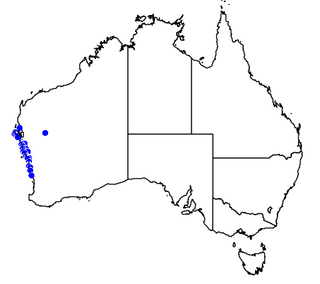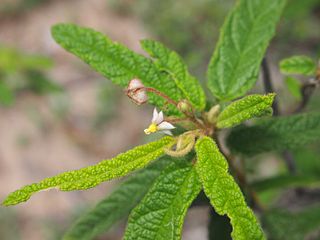
Commersonia is a genus of twenty-five species of flowering plants in the family Malvaceae. Plants in this genus are shrubs or trees, occurring from Indochina to Australia and have stems, leaves and flowers covered with star-like hairs. The leaves are simple, often with irregularly-toothed edges, the flowers bisexual with five sepals, five petals and five stamens and the fruit a capsule with five valves. The genus underwent a revision in 2011 and some species were separated from Commersonia, others were added from Rulingia.

Guichenotia is a genus of 17 species of flowering plants in the family Malvaceae that is endemic to the south west of Western Australia. Plants in the genus Guichenotia are shrubs with simple, linear to oblong leaves with leaf-like stipules at the base of the petiole, the flowers bisexual with three bracteoles at the base of the sepals, and five petal-like sepals, the petals sometimes absent. The fruit is a capsule usually containing 15 seeds.

Lasiopetalum, commonly known as velvet bushes, is a genus of about forty-five species of flowering plants in the family Malvaceae, all endemic to Australia.
Rulingia is a genus of flowering plants native to Australia and Madagascar. In 2011, all species were transferred to Commersonia with the exception of Rulingia cuneata, R. loxophylla, R. luteiflora and R. procumbens which have been transferred to the new genus Androcalva.

Androcalva fraseri, commonly known as blackfellow's hemp or brush kurrajong, is a species of flowering plant in the family Malvaceae and is endemic to eastern Australia. It is a small tree or shrub that forms suckers and has egg-shaped or lance-shaped leaves with serrated edges, and clusters of 13 to 21 white flowers.

Androcalva is a genus of 33 species of flowering plants in the family Malvaceae and is endemic to continental Australia.

Commersonia borealis is a species of flowering plant in the family Malvaceae and is endemic to the southwest of Western Australia. It is a low growing, spreading shrub with egg-shaped to oblong leaves, and white, yellow and cream-coloured flowers.

Seringia corollata is a shrub of the family Malvaceae native to inland New South Wales and Queensland in eastern Australia.

Seringia integrifolia, commonly known as common firebush, is a species of flowering plant in the family Malvaceae and endemic to the south-west of Western Australia. It is a small, much-branched shrub, its young growth densely covered with woolly, white or rust-coloured hairs. The leaves are oblong, 8.5–17 mm (0.33–0.67 in) long, more or less glabrous on the upper surface and densely covered with woolly white hairs on the lower surface. The flowers are arranged in small, loose groups with thin, egg-shaped bracts that fall off as the flowers open. The sepal lobes are broad, pointed, mostly 6.5–8.5 mm (0.26–0.33 in) long and the ovary has 5 carpels with about 4 ovules in each. The fruit is a spherical, softly hairy capsule.

Seringia hermanniifolia, commonly known as crinkle-leaved firebush, is a shrub of the family Malvaceae. It is a small shrub with blue-purple flowers and is endemic to Western Australia.

Cyathostemon ambiguus is a member of the family Myrtaceae endemic to Western Australia.

Seringia is a genus of about 18 species of plants in the family Malvaceae. Species of Seringia are native to Australia, New Guinea, and Madagascar. They are small shrubs with soft silken leaves. The flowers are purple or mauve and appear in profusion. The calyx is the most conspicuous part of the flower.

Androcalva rosea, commonly known as Sandy Hollow commersonia, is a small endangered shrub with pink flowers and prostrate trailing branches. It is only known from four locations in the Hunter Valley of New South Wales.
Carolyn F. Wilkins is an Australian botanist, who currently works for the Western Australian Department of Biodiversity, Conservation and Attractions.
Seringia exastia, also known as fringed fire-bush, is a species of flowering plant in the mallow family and is endemic to the Kimberley region of Western Australia.

Lasiopetalum glutinosum is a species of flowering plant in the family Malvaceae and is endemic to the south-west of Western Australia. It is a spreading, multi-stemmed shrub with densely hairy young stems, egg-shaped leaves often with three lobes and bright pink or dark red flowers.

Lasiopetalum oldfieldii is a species of flowering plant in the family Malvaceae and is endemic to the south-west of Western Australia. It is a low, spreading shrub with rusty-hairy young stems, egg-shaped to narrowly egg-shaped leaves and pink and dark red flowers.

Lasiopetalum oppositifolium is a species of flowering plant in the family Malvaceae and is endemic to the south-west of Western Australia. It is an open, erect shrub with rusty-hairy young stems, linear, narrowly elliptic or narrowly egg-shaped leaves and white, pink and dark red flowers.

Androcalva loxophylla is a species of flowering plant in the family Malvaceae and is endemic to northern Australia. It is a shrub with spreading or low-lying branches, oblong to broadly elliptic leaves and clusters of 4 to 20 yellow flowers.

Androcalva melanopetala is a species of flowering plant in the family Malvaceae and is endemic to southern inland Western Australia. It is a sometimes prostrate shrub that has densely hairy new growth, egg-shaped to elliptic leaves with rounded teeth on the edges, and clusters of white or cream-coloured and pink to red flowers.

















